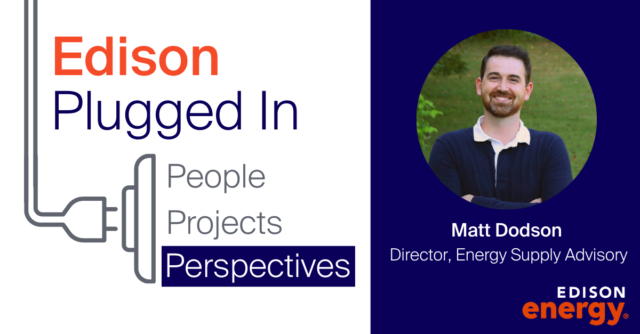
July 12, 2022
Rethinking onsite energy solutions will be key for corporates to meet sustainability goals: “It’s critical not to look at these solutions as binary”
By Elana Knopp, Senior Content Writer

In this first of a two-part series, Matt Dodson, Director of Energy Supply Advisory at Edison Energy, discusses his holistic approach to helping corporate clients meet bold sustainability targets, including carbon reduction road-mapping, performance validation of onsite and offsite PPAs, and the deployment of onsite solar and storage.
Part I
Earlier this year, the Securities and Exchange Commission (SEC) proposed rule changes that would require publicly traded companies to include disclosures around climate-related risks that could have a material impact on their business, operations, or financial condition.
This includes disclosure of a company’s greenhouse gas (GHG) emissions, which has become a commonly used metric to assess exposure to such risks.
“As an industry, we’re aware that most publicly traded or privately owned clients have received direct feedback from customers and investors on the importance of their actions as it pertains to their climate change commitments and clean energy goals,” said Matt Dodson, Director of Energy Supply Advisory at Edison Energy. “For some industries like tech, for instance, it’s almost a daily conversation. My belief is that there are warranted ESG pressures coming from multiple angles impacting our clients, and rightly so.”
Dodson and his team at Edison Energy help clients rise to the challenge, often beginning with sustainability and incorporating components like GHG inventory, carbon reduction road-mapping, and performance validation of large offsite and onsite PPAs, as well the development of new onsite solar and storage.
“Monitoring performance has become a critical piece of our clients’ broader strategy to attain net-zero goals and SBTi commitments,” Dodson said. “Our role is to collaboratively plan a long-term vision with our clients on what they can realistically do to directly reduce emissions at their sites and facilities. That’s why we intentionally start from a full portfolio view and take the approach of planning longer-term targets for onsite clean energy assets, as opposed to jumping right into one facility. We’d love to do 20 sites at a time or more but can also really focus in on a few key facilities if that’s right for our clients.”
When exploring renewables procurement, large portfolio clients often focus solely on offsite projects, dismissing onsite generation for a host of reasons. These include the availability of wind and solar resources; access to incentives, tariffs, and rebates; and land or roof space constraints. Additionally, offsite renewable energy projects are often more attractive to clients because they are typically much larger and can cover significant load.
But Dodson is pushing for energy buyers to rethink onsite energy solutions.
“It’s been really easy and, frankly, natural, for corporate buyers to place an onsite solar strategy on the back burner, particularly when comparing it to a 100 MW wind or solar farm,” he said. “If you’re looking at onsite solar as the means to get to your 100 percent renewable goals, that’s always going to be challenging because you’re limited based on roof space or nearby land to get to a 50 or 100 percent emissions reduction. Our continued excitement and how we’re leading with clients is diving into the details around local incentives, supportive policy, and tangible ways that solar makes business sense for our global clients.”
According to Dodson, a thoughtful onsite portfolio can also unlock new offsite PPA opportunities, particularly from the perspective of recent headwinds on pricing for those types of contracts. In addition, highlighting the monetary value that onsite solar can bring to a corporate CFO could be the tipping point for a company deciding to sign an additional offsite agreement.
Dodson approaches onsite renewable energy solutions as a nuanced, curated portfolio of high-value, tangible assets that bring positive cash flows directly into clients’ facilities, coupling that with offsite wind and solar to attain a clients’ clean energy goals.
“For me and our team, it’s critical not to look at these solutions as binary,” he said. “If a client is able to mobilize on both onsite and offsite work, that’s when a true holistic approach to clean energy procurement is built. Then there is also risk mitigation between technologies and solutions. All these things can be very valuable to our clients.”
Click here to explore previous installments in our Edison Plugged In Series and stay tuned for the second part of our conversation with Matt.
Join Our Mailing List
Supply Chain Decarbonization: Your Guide is Here!
Download our new white paper on establishing a successful decarbonization program.
Read More



